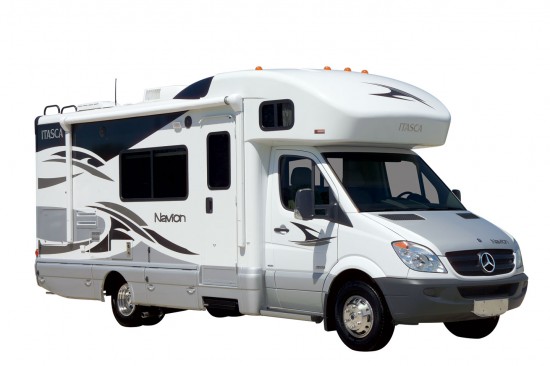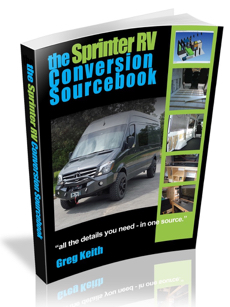
Which is the best-built class C Sprinter RV? A number of readers have asked me that question, and after traipsing through many class C Sprinters and talking to manufacturers for my 2012 Sprinter RV Buyer’s Guide, I should have some opinions. But I find that question hard to answer, and here’s why: North American class B and class C Sprinter motorhomes seem to be getting more similar all the time. Last week I was at the Colorado RV Adventure show and examined as many Sprinter-based RVs as I could. The equipment used in these American Sprinter RV conversions is getting more identical across brands and models every year:
- the same SMEV (Dometic in the US) sinks and 2- or 3-burner propane cooktops
- the same few types of Dometic & Norcold refrigerators
- the same Suburban and Atwood water heaters and furnaces
- the same Onan generators
- the same mounts for flat-screen TVs
- even the same struts holding up overhead cabinet doors!
- The best RVs use the highest-quality materials and equipment – Probably true, but hard to see just from a walk-through. You need to do a factory tour in person, or see a detailed factory tour video that shows the specific model being built.
- The best RVs last the longest – Maybe. But unless you’re a very experienced RVer and objective about your real needs, you might not pick the RV that’s perfect for you right away. You may sell your RV, for a number of reasons, long before it starts having any “aging” issues.
- The best RV is the best value for the least money – What is the best value? The sturdiest? Sturdy often means heavy, which is bad for gas mileage. The most full-featured? If you paid US$120K for a Class C Sprinter with all the bells and whistles, and you never use the 2nd TV, the shower (many RVers report that they end up using campground showers, and use their RV shower as a closet!), was it worth the big price tag?
With that in mind, I propose three categories of class C Sprinter RVs:
- Winnebago View – In 2010, according to RV Business magazine, the Winnebago View was reportedly the top-selling Class C diesel motorhome with 21.9% market share of that segment (and in two months on the road this past summer, most of the Sprinter RVs I saw were Winnebago Views). Winnebago claims that “all of our appliances & cabinets are securely anchored in steel panels mounted in the sidewalls, others use weaker (and cheaper) pine boards“. Any proof for this claim? Yes, this Winnebago factory tour video shows building a class A’s sidepanels with the steel frame shown at 10:55. So they definitely build some of their RVs this way, but do they build the View/View Profile this way, and the Navion/Navion iQ? Worth finding out. Many dealers I’ve met wonder how Winnebago manages to build the Era for such a low price, and competitors claim that it’s because it’s poor quality. It’s certainly true that lots of companies have high-end and low-end products, and sometimes you get the quality you pay for.
- Forest River Solera – at the RV show, a 2012 Solera was on sale for US$82K, compared to the regular list price of US$120K. Several other people remarked on what a great deal this seemed to be for the amount of living space the Solera (shown in this walk-through) offers. The inside is extremely spacious with the slide-out deployed, there are a lot of windows and all of them open except one, tons of storage in cabinets inside and body storage compartments outside, 3 opening skylights, a big shower, sleeps 6 people in 3 beds! Possible negatives: seemingly very soft suspension shook very noticeably just walking in and out (though I think everyone with a fully-loaded class C Sprinter will want to put some money into good aftermarket suspension mods), may not have the greatest fuel mileage, considering its weight.
- Fleetwood has four Sprinter Class C diesel models, the Jamboree and Tioga Ranger (two more expensive, two less so). I haven’t seen these yet in person, and I haven’t found a factory video. But their Jamboree diesel Web site claims that Fleetwood’s Tuff-Ply roofing (which is TPO, actually) is one of the most durable roofing materials – RV roofs can be metal, EPDM rubber, TPO (rubber-coated fabric), or fiberglass. Many say that fiberglass is one of the best choices since it can stay fairly cool and is repairable if there are cracks. Fleetwood also notes that they use “TuffPEX” plumbing, which is great – good-quality PEX plumbing may be the most durable RV plumbing currently in use. They use one seamless and solid piece of fiberglass for each outer wall, and “Vacu-Bond® Sidewalls, Floors And Ceilings ensure a strong, weather-resistant structure” – not sure how to evaluate this claim. A one-piece fiberglass shell doesn’t have any leakage worries. They also use high-density block foam insulation. So I haven’t got an opinion yet on whether Fleetwood’s claims are true, but at the price, these models are worth checking out.
- Coach House Platinum – Is it well-made? See the 2008 factory tour video (which isn’t on the Sprinter chassis, so it would be nice to have an update): Coach House says that they build the living quarters in a Platinum on a 1.5″ steel frame bolted onto the chassis, that the insulation used gives sidewalls and roofs an R28 value, that the one-piece fiberglass shell is light, aerodynamic and won’t leak (no seams or roof joints). Their cabinets are stapled, screwed and glued together for strength, their bulkhead walls are 3/4″ white maple, and they have a 3 year, 36000-mile warranty. I haven’t actually set foot into one of these yet, so I don’t know if all these claims are still true of the Sprinter-based Platinums, but if so, this seems really well-made.
- Leisure Travel Vans Serenity – The new 2012 model LTV Serenity (list price US$136K at the show) has a huge opening hatch/skylight up front, which provides lots of light, an aerodynamic fiberglass honeycomb shell which gives the Serenity a fairly low profile, lots of inside storage in the cabinetry, open layout, a sliding divider curtain between front and back spaces, sleeps and seats 4, giant 12′ x 8′ power awning. Possible negatives – interior height is only 6’2″, if you’re tall, you may find this rig too short for you, minimal exterior storage compartments.
- Leisure Travel Vans Unity – The 2012 LTV Unity also has a skylight, though smaller than the Serenity’s, a bathroom with triple-mirror vanity and huge shower, giant 12′ x 8′ power awning, and the much-vaunted Murphy bed. This Murphy bed doesn’t appeal to me: although it’s clever to have a dual-use space, it takes work to get the bed up and down, including moving the fixed chairs away and folding them down, reducing the height of the uncooperative center table, carefully lowering the bed and ensuring the driver’s seat is far enough forward not to be caught on the lowering bed. I imagine all sorts of possible scenarios where this bed could not work, break things, or injure someone (especially if you have small kids).
ASKING YOUR FEEDBACK: Did I answer the original question, or have I just muddied the waters? Did I leave out some important criteria? Please comment on this post, and let me know your opinions!




Comments on this entry are closed.